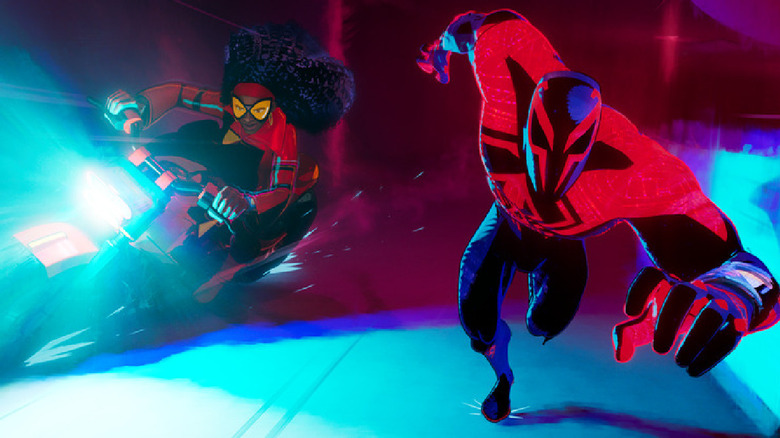Spider-Man: Across The Spider-Verse Writers On Making A Bigger, Better Sequel - Exclusive Interview
Released in 2018, "Spider-Man: Into the Spider-Verse" was a game-changing movie for both the superhero and animation genres. It featured the screen introduction of Miles Morales (voiced by Shameik Moore), the Black/Puerto Rican teen who becomes Spider-Man in a universe adjacent to ours and discovers not only that he is imbued with incredible powers, but also that he is just one of untold numbers of Spider-People all inhabiting different realities in the multiverse known as the Spider-Verse.
The new sequel, "Spider-Man: Across the Spider-Verse," offers up the same dazzling, groundbreaking mix of animation styles as the first film while sending Miles even further into the mysteries of the Spider-Verse. As he battles a villain called the Spot (Jason Schwartzman), who generates dimension-opening portals within his own body, Miles learns of the Spider Society, a legion of Spider-Heroes who protect the fabric of reality, led by Spider-Man 2099/Miguel O'Hara (Oscar Isaac). But the Spider Society may not be the support group and superhero team that Miles desperately wants.
Also returning for the sequel are Hailee Steinfeld as Gwen Stacy/Spider-Gwen and Jake Johnson as Peter B. Parker, an alternate Spider-Man who acts as a mentor to Miles. Debuting as members of the Spider Society are Issa Rae as Jessica Drew/Spider-Woman and Daniel Kaluuya as Hobie Brown/Spider-Punk, not to mention many, many more Spider-People.
Directed by Joaquim Dos Santos, Kemp Powers, and Justin K. Thompson, "Across the Spider-Verse" is once again the brainchild of writers-producers Phil Lord and Chris Miller, who produced the first movie (which Lord co-wrote) and wanted the sequel to surpass the original. "We knew we needed to make audiences feel that same level of surprise and delight," Miller told Looper in our exclusive interview. "And that meant that we needed to give them a whole bunch of new experiences."
Following up an instant classic
The first one was an Oscar winner, big hit at the box office with fans and critics, high marks for representation ... so no pressure to follow up, right?
Phil Lord: I know. It's a hard bar to clear. We were all playing tight for a little while, and then we realized you had to swing for the fences and pray that you made contact.
Chris Miller: People were so surprised and delighted at the first one, and it felt like they had seen something they'd never seen before. The worst thing to do was to give them more of that, the same thing they had already seen. We knew we needed to make audiences feel that same level of surprise and delight, and that meant that we needed to give them a whole bunch of new experiences. That's why the opportunity to take Miles into a bunch of different worlds — that each had its own art style and own cinematic language — was a way to give people something that felt like, "Wow, I've never seen anything like this."
Bringing in the right Spider-People for the story
As you started to put all this together, did you start to have ideas of which new Spider-People you wanted to bring in?
Lord: It was all based on what would help us tell the story about Miles and the kinds of allies and adversaries that you encounter when you leave the nest for the first time. The addition of Hobie Brown was an effort to [explore how] you meet somebody who's much more advanced than you, and maybe you don't like them because you're insecure around them. We thought that was a really interesting ally for Miles to make.
There was a promise at the end of the first movie with Miguel O'Hara showing up in a post-credits scene and Oscar Isaac voicing him. Did you always know that he would be able to come back and do this one?
Lord: We were hoping. We made a kind of gentleperson's agreement when he agreed to do [the first movie's end credits scene]. I remember we reached out to him and said, "Just do this. We'll figure out the deal for if there's another movie; we'll figure it out when we get there." Luckily, we did, because he's such an important part of this one.
Miller: He's so perfect for that part. He has total command, but ... you can see the humanity underneath it. He's funny also, which is great. It's something that is required for all of these characters — being able to be vulnerable, be funny, be tough when they need to be, be aspirational. The range of this team of actors on this film in what we asked them to do, and what they were able to pull off, is remarkable.
The dorkiest villain ever
How did you land on the Spot as your big bad? Spidey's got such an array of villains.
Lord: There have been a lot of villains that have been deployed in a lot of different Spider-People movies, so you start to go, "What can we do that's unexpected?" I believe it was an idea of [producer] Avi Arad's, which is, "You should use the Spot." We were like, "Okay, Avi, that's a very ridiculous ... that's a very bad idea."
Miller: [He's] the dorkiest villain I've ever seen.
Lord: He's truly the dorkiest villain that Spider-Man ever faced. [We said to Avi], "Please shut up about it." Then about six months later, we were like, "What if it was the Spot?" Avi's like, "I told you. He's got a great power, and nobody realizes it." We were really intrigued by that idea of, "What if a villain also had a coming-of-age narrative?" It was a villain's journey story.
"Spider-Man: Across the Spider-Verse" swings into theaters on Friday, June 2.
This interview has been edited for clarity.



